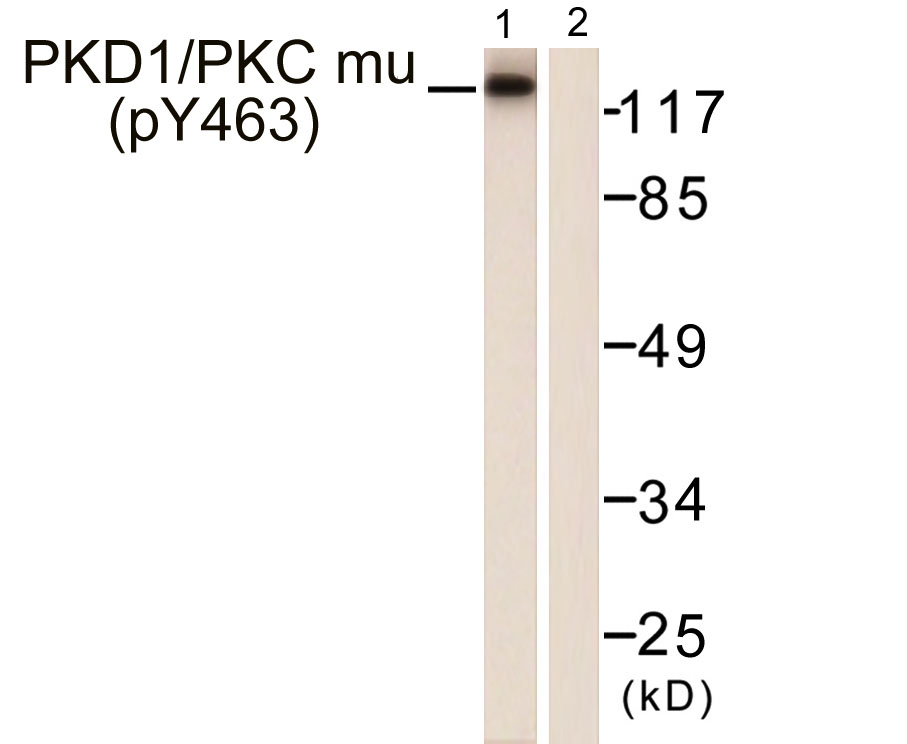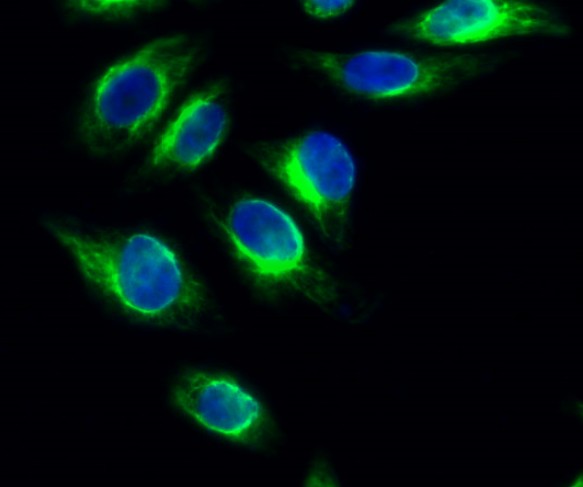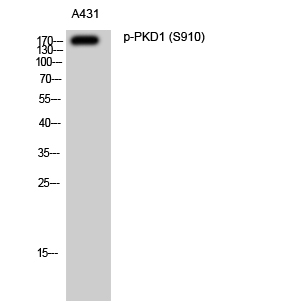PKD1 (phospho Tyr463) Polyclonal Antibody
- Catalog No.:YP0721
- Applications:WB;IHC;IF;ELISA
- Reactivity:Human;Mouse;Rat
- Target:
- PKD1
- Fields:
- >>Rap1 signaling pathway;>>Aldosterone synthesis and secretion;>>Chemical carcinogenesis - reactive oxygen species
- Gene Name:
- PRKD1
- Protein Name:
- Serine/threonine-protein kinase D1
- Human Gene Id:
- 5587
- Human Swiss Prot No:
- Q15139
- Mouse Gene Id:
- 18760
- Mouse Swiss Prot No:
- Q62101
- Rat Gene Id:
- 85421
- Rat Swiss Prot No:
- Q9WTQ1
- Immunogen:
- The antiserum was produced against synthesized peptide derived from human PKD1/PKC mu around the phosphorylation site of Tyr463. AA range:429-478
- Specificity:
- Phospho-PKD1 (Y463) Polyclonal Antibody detects endogenous levels of PKD1 protein only when phosphorylated at Y463.
- Formulation:
- Liquid in PBS containing 50% glycerol, 0.5% BSA and 0.02% sodium azide.
- Source:
- Polyclonal, Rabbit,IgG
- Dilution:
- WB 1:500 - 1:2000. IHC 1:100 - 1:300. ELISA: 1:40000.. IF 1:50-200
- Purification:
- The antibody was affinity-purified from rabbit antiserum by affinity-chromatography using epitope-specific immunogen.
- Concentration:
- 1 mg/ml
- Storage Stability:
- -15°C to -25°C/1 year(Do not lower than -25°C)
- Other Name:
- PRKD1;PKD;PKD1;PRKCM;Serine/threonine-protein kinase D1;Protein kinase C mu type;Protein kinase D;nPKC-D1;nPKC-mu
- Observed Band(KD):
- 130kD
- Background:
- PRKD1 is a serine/threonine kinase that regulates a variety of cellular functions, including membrane receptor signaling, transport at the Golgi, protection from oxidative stress at the mitochondria, gene transcription, and regulation of cell shape, motility, and adhesion (summary by Eiseler et al., 2009 [PubMed 19329994]).[supplied by OMIM, Nov 2010],
- Function:
- catalytic activity:ATP + a protein = ADP + a phosphoprotein.,enzyme regulation:Activated by diacylglycerol and phorbol esters.,function:Calcium-independent, phospholipid-dependent, serine- and threonine-specific kinase involved in resistance to oxidative stress.,PTM:Phosphorylation of Ser-738 and/or Ser-742 in activated PKD is mediated by transphosphorylation (By similarity). Phosphorylation of Tyr-463 mediated by the Src/Abl pathway in response to oxidative stress activates the kinase.,similarity:Belongs to the protein kinase superfamily.,similarity:Belongs to the protein kinase superfamily. CAMK Ser/Thr protein kinase family. PKD subfamily.,similarity:Contains 1 PH domain.,similarity:Contains 1 protein kinase domain.,similarity:Contains 2 phorbol-ester/DAG-type zinc fingers.,subunit:Interacts (via N-terminus) with ADAP1/CENTA1. Interacts with Src.,
- Subcellular Location:
- Cytoplasm . Cell membrane . Golgi apparatus, trans-Golgi network . Translocation to the cell membrane is required for kinase activation.
- Expression:
- Placenta,Testis,
- June 19-2018
- WESTERN IMMUNOBLOTTING PROTOCOL
- June 19-2018
- IMMUNOHISTOCHEMISTRY-PARAFFIN PROTOCOL
- June 19-2018
- IMMUNOFLUORESCENCE PROTOCOL
- September 08-2020
- FLOW-CYTOMEYRT-PROTOCOL
- May 20-2022
- Cell-Based ELISA│解您多样本WB检测之困扰
- July 13-2018
- CELL-BASED-ELISA-PROTOCOL-FOR-ACETYL-PROTEIN
- July 13-2018
- CELL-BASED-ELISA-PROTOCOL-FOR-PHOSPHO-PROTEIN
- July 13-2018
- Antibody-FAQs
- Products Images

- Enzyme-Linked Immunosorbent Assay (Phospho-ELISA) for Immunogen Phosphopeptide (Phospho-left) and Non-Phosphopeptide (Phospho-right), using PKD1/PKC mu (Phospho-Tyr463) Antibody

- Immunohistochemistry analysis of paraffin-embedded human brain, using PKD1/PKC mu (Phospho-Tyr463) Antibody. The picture on the right is blocked with the phospho peptide.

- Western blot analysis of lysates from HepG2 cells, using PKD1/PKC mu (Phospho-Tyr463) Antibody. The lane on the right is blocked with the phospho peptide.


